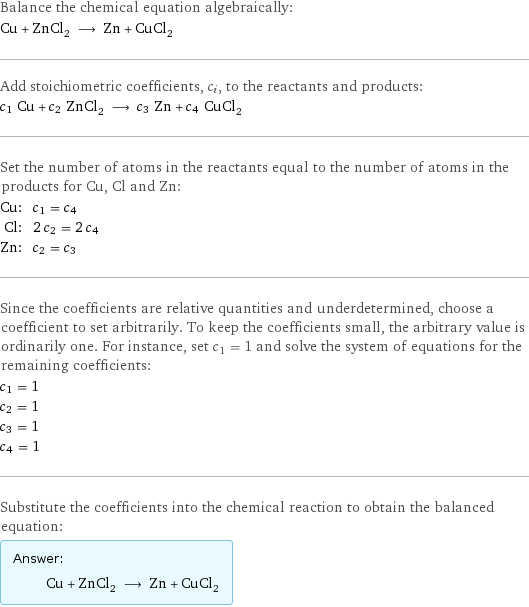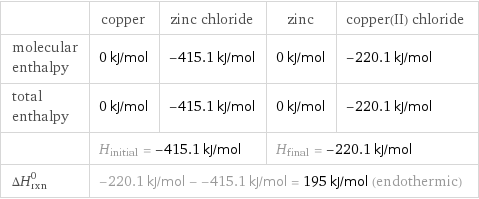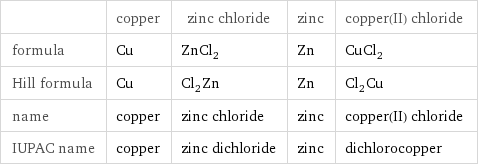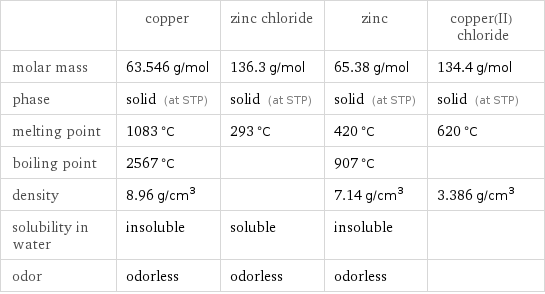Input interpretation

Cu copper + ZnCl_2 zinc chloride ⟶ Zn zinc + CuCl_2 copper(II) chloride
Balanced equation

Balance the chemical equation algebraically: Cu + ZnCl_2 ⟶ Zn + CuCl_2 Add stoichiometric coefficients, c_i, to the reactants and products: c_1 Cu + c_2 ZnCl_2 ⟶ c_3 Zn + c_4 CuCl_2 Set the number of atoms in the reactants equal to the number of atoms in the products for Cu, Cl and Zn: Cu: | c_1 = c_4 Cl: | 2 c_2 = 2 c_4 Zn: | c_2 = c_3 Since the coefficients are relative quantities and underdetermined, choose a coefficient to set arbitrarily. To keep the coefficients small, the arbitrary value is ordinarily one. For instance, set c_1 = 1 and solve the system of equations for the remaining coefficients: c_1 = 1 c_2 = 1 c_3 = 1 c_4 = 1 Substitute the coefficients into the chemical reaction to obtain the balanced equation: Answer: | | Cu + ZnCl_2 ⟶ Zn + CuCl_2
Structures

+ ⟶ +
Names

copper + zinc chloride ⟶ zinc + copper(II) chloride
Reaction thermodynamics
Enthalpy

| copper | zinc chloride | zinc | copper(II) chloride molecular enthalpy | 0 kJ/mol | -415.1 kJ/mol | 0 kJ/mol | -220.1 kJ/mol total enthalpy | 0 kJ/mol | -415.1 kJ/mol | 0 kJ/mol | -220.1 kJ/mol | H_initial = -415.1 kJ/mol | | H_final = -220.1 kJ/mol | ΔH_rxn^0 | -220.1 kJ/mol - -415.1 kJ/mol = 195 kJ/mol (endothermic) | | |
Equilibrium constant
![Construct the equilibrium constant, K, expression for: Cu + ZnCl_2 ⟶ Zn + CuCl_2 Plan: • Balance the chemical equation. • Determine the stoichiometric numbers. • Assemble the activity expression for each chemical species. • Use the activity expressions to build the equilibrium constant expression. Write the balanced chemical equation: Cu + ZnCl_2 ⟶ Zn + CuCl_2 Assign stoichiometric numbers, ν_i, using the stoichiometric coefficients, c_i, from the balanced chemical equation in the following manner: ν_i = -c_i for reactants and ν_i = c_i for products: chemical species | c_i | ν_i Cu | 1 | -1 ZnCl_2 | 1 | -1 Zn | 1 | 1 CuCl_2 | 1 | 1 Assemble the activity expressions accounting for the state of matter and ν_i: chemical species | c_i | ν_i | activity expression Cu | 1 | -1 | ([Cu])^(-1) ZnCl_2 | 1 | -1 | ([ZnCl2])^(-1) Zn | 1 | 1 | [Zn] CuCl_2 | 1 | 1 | [CuCl2] The equilibrium constant symbol in the concentration basis is: K_c Mulitply the activity expressions to arrive at the K_c expression: Answer: | | K_c = ([Cu])^(-1) ([ZnCl2])^(-1) [Zn] [CuCl2] = ([Zn] [CuCl2])/([Cu] [ZnCl2])](../image_source/cfe51694032fc2cafd2f3b3bdac2d32b.png)
Construct the equilibrium constant, K, expression for: Cu + ZnCl_2 ⟶ Zn + CuCl_2 Plan: • Balance the chemical equation. • Determine the stoichiometric numbers. • Assemble the activity expression for each chemical species. • Use the activity expressions to build the equilibrium constant expression. Write the balanced chemical equation: Cu + ZnCl_2 ⟶ Zn + CuCl_2 Assign stoichiometric numbers, ν_i, using the stoichiometric coefficients, c_i, from the balanced chemical equation in the following manner: ν_i = -c_i for reactants and ν_i = c_i for products: chemical species | c_i | ν_i Cu | 1 | -1 ZnCl_2 | 1 | -1 Zn | 1 | 1 CuCl_2 | 1 | 1 Assemble the activity expressions accounting for the state of matter and ν_i: chemical species | c_i | ν_i | activity expression Cu | 1 | -1 | ([Cu])^(-1) ZnCl_2 | 1 | -1 | ([ZnCl2])^(-1) Zn | 1 | 1 | [Zn] CuCl_2 | 1 | 1 | [CuCl2] The equilibrium constant symbol in the concentration basis is: K_c Mulitply the activity expressions to arrive at the K_c expression: Answer: | | K_c = ([Cu])^(-1) ([ZnCl2])^(-1) [Zn] [CuCl2] = ([Zn] [CuCl2])/([Cu] [ZnCl2])
Rate of reaction
![Construct the rate of reaction expression for: Cu + ZnCl_2 ⟶ Zn + CuCl_2 Plan: • Balance the chemical equation. • Determine the stoichiometric numbers. • Assemble the rate term for each chemical species. • Write the rate of reaction expression. Write the balanced chemical equation: Cu + ZnCl_2 ⟶ Zn + CuCl_2 Assign stoichiometric numbers, ν_i, using the stoichiometric coefficients, c_i, from the balanced chemical equation in the following manner: ν_i = -c_i for reactants and ν_i = c_i for products: chemical species | c_i | ν_i Cu | 1 | -1 ZnCl_2 | 1 | -1 Zn | 1 | 1 CuCl_2 | 1 | 1 The rate term for each chemical species, B_i, is 1/ν_i(Δ[B_i])/(Δt) where [B_i] is the amount concentration and t is time: chemical species | c_i | ν_i | rate term Cu | 1 | -1 | -(Δ[Cu])/(Δt) ZnCl_2 | 1 | -1 | -(Δ[ZnCl2])/(Δt) Zn | 1 | 1 | (Δ[Zn])/(Δt) CuCl_2 | 1 | 1 | (Δ[CuCl2])/(Δt) (for infinitesimal rate of change, replace Δ with d) Set the rate terms equal to each other to arrive at the rate expression: Answer: | | rate = -(Δ[Cu])/(Δt) = -(Δ[ZnCl2])/(Δt) = (Δ[Zn])/(Δt) = (Δ[CuCl2])/(Δt) (assuming constant volume and no accumulation of intermediates or side products)](../image_source/714e43db0ed885817fcfd04dce32ae13.png)
Construct the rate of reaction expression for: Cu + ZnCl_2 ⟶ Zn + CuCl_2 Plan: • Balance the chemical equation. • Determine the stoichiometric numbers. • Assemble the rate term for each chemical species. • Write the rate of reaction expression. Write the balanced chemical equation: Cu + ZnCl_2 ⟶ Zn + CuCl_2 Assign stoichiometric numbers, ν_i, using the stoichiometric coefficients, c_i, from the balanced chemical equation in the following manner: ν_i = -c_i for reactants and ν_i = c_i for products: chemical species | c_i | ν_i Cu | 1 | -1 ZnCl_2 | 1 | -1 Zn | 1 | 1 CuCl_2 | 1 | 1 The rate term for each chemical species, B_i, is 1/ν_i(Δ[B_i])/(Δt) where [B_i] is the amount concentration and t is time: chemical species | c_i | ν_i | rate term Cu | 1 | -1 | -(Δ[Cu])/(Δt) ZnCl_2 | 1 | -1 | -(Δ[ZnCl2])/(Δt) Zn | 1 | 1 | (Δ[Zn])/(Δt) CuCl_2 | 1 | 1 | (Δ[CuCl2])/(Δt) (for infinitesimal rate of change, replace Δ with d) Set the rate terms equal to each other to arrive at the rate expression: Answer: | | rate = -(Δ[Cu])/(Δt) = -(Δ[ZnCl2])/(Δt) = (Δ[Zn])/(Δt) = (Δ[CuCl2])/(Δt) (assuming constant volume and no accumulation of intermediates or side products)
Chemical names and formulas

| copper | zinc chloride | zinc | copper(II) chloride formula | Cu | ZnCl_2 | Zn | CuCl_2 Hill formula | Cu | Cl_2Zn | Zn | Cl_2Cu name | copper | zinc chloride | zinc | copper(II) chloride IUPAC name | copper | zinc dichloride | zinc | dichlorocopper
Substance properties

| copper | zinc chloride | zinc | copper(II) chloride molar mass | 63.546 g/mol | 136.3 g/mol | 65.38 g/mol | 134.4 g/mol phase | solid (at STP) | solid (at STP) | solid (at STP) | solid (at STP) melting point | 1083 °C | 293 °C | 420 °C | 620 °C boiling point | 2567 °C | | 907 °C | density | 8.96 g/cm^3 | | 7.14 g/cm^3 | 3.386 g/cm^3 solubility in water | insoluble | soluble | insoluble | odor | odorless | odorless | odorless |
Units
